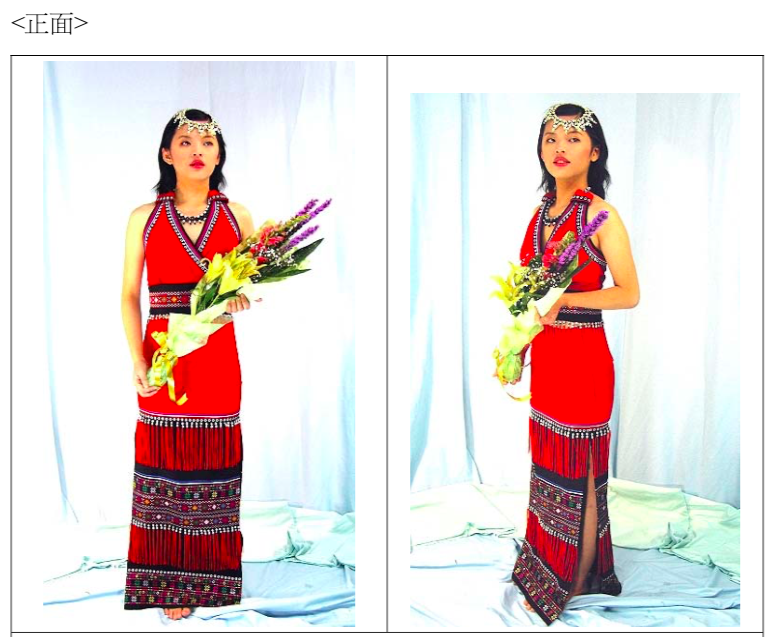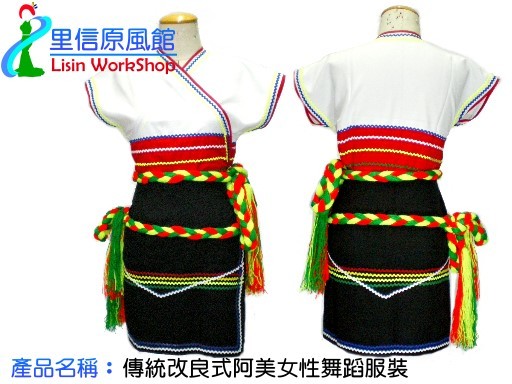今天介紹一套里信在2006年參賽的作品-太陽的兒女,是里信利用薏苡(阿美族語fafaklr(法洛兒),俗稱:精靈種子、魔鬼珠)縫製的阿美族時尚禮服。
Allow me to introduce a set of works by Lisin that participated in a competition in 2006 called "Children of the Sun." This collection features Amis tribal fashionable ceremonial attire meticulously crafted by Lisin using Job's tears (known as "faker" in the Amis language and commonly referred to as "elf seeds" or "devil's pearls").
Fangcalay liku’ no pangcah-Wawa no cidal
(語譯:阿美族漂亮的衣服-太陽的兒女,Aboriginal Canonicals of Pangcah-Daughter of Sun)

以精靈種子法洛兒縫製的頭飾,象徵頭頂上有太陽的庇佑;以瓔絡項鍊般的連結成串象徵傳統風格與現代創意的結盟;多樣化的花色圖騰圍繞裙上,如族群人們相親相愛以大地為一家人;流蘇如陽光光芒四射,隨著精靈種子法洛兒互相以對,使流蘇的動態感與法洛兒的大理石色澤更能代表陽光照射的動態感,與照在法洛兒時,所呈現的靜態感,這更呈現了大地母親對兒女的雙面表達,是希冀,也是關愛包容。 The headpiece crafted with "fafaklr" represents the blessing of the sun shining upon the wearer's head. The interconnected strands of the necklace symbolize the alliance between traditional style and modern creativity, resembling the unity of the community. The diverse patterns and motifs surrounding the skirt represent the love and harmony among the people, just like a big family rooted in the earth. The tassels radiate like the rays of the sun, intertwining with the Job's tears, expressing the dynamic energy of sunlight. The combination of the tassels' movement and the marbled colors of the Job's tears represents the dynamic nature of sunlight, while the static presence of the marbled colors represents the stillness when illuminated by sunlight. This duality further embodies the Earth Mother's expression of hope, love, and inclusiveness towards her children.

由側面可看到,禮服使其腰身明顯,束腰似的上衣下擺襯托出母親肩起撫育的責任,猶如太陽的光芒讓大地充滿生機。開叉的裙,是太陽女兒在這片土地孕育新生的法則,神秘的透露著孕育下一代的方式,為了擔負養兒育女的大任,露出腿是為了努力的走,為兒女開創前面的道路。 The ceremonial attire showcases a distinct waistline, resembling a cinched waist. The flared hem of the top accentuates the nurturing responsibility that rests upon a mother's shoulders, much like the rays of the sun that fill the earth with vitality. The split skirt symbolizes the rule of the sun's daughters in nurturing new life on this land. It mystically reveals the ways of nurturing the next generation. By embracing the duty of raising children, the exposed legs represent the determination to walk diligently and pave the way for the future of their children.

背面的上衣中繫繩連結有一種如同鈴鐺形狀的縫繡飾,是象徵著包容過去,而在前面由鈴鐺狀的縫繡飾延伸,象徵太陽女兒哺乳的神聖,延伸是在母親的關愛下展望未來,由後面的鈴鐺縫繡飾垂掛下的流蘇,是陽光在黑暗中保留的一絲光線,極力的想將黑暗的地方有一點光明,就好像母親關懷兒女最深層的內心,想多了解兒女的心思並給予幫助。裙子的後襬拖著地,象徵著太陽女兒不辭勞苦的付出。 At the back of the ceremonial attire, the connected cords in the middle of the blouse feature embroidery in the shape of bells or bells. This represents the embracing of the past. Extending from the bell-shaped embroidery in the front symbolizes the sacred act of breastfeeding by the sun's daughters. It represents the extension of care from the mother, looking towards the future. The tassels hanging down from the bell embroidery at the back are like a ray of light preserved by the sun in the darkness, striving to bring a glimmer of light to the dark places. It reflects a mother's deepest care and desire to understand her children's thoughts and provide assistance. The trailing back hem of the skirt symbolizes the tireless dedication of the sun's daughters.
看到這裡,眼尖心細的小里信們,應該不難看得出來,里信常用母親的視角來設計服裝,除了跟阿美族是母系社會有關之外,里信希冀用服裝來尊榮母親,讓母親能穿上美麗的阿美族服,便是讓里信所設計的服裝,總是能嗅到滿溢出來對母親的愛及追念。你也可以看本館傳統服飾的配色,雖說都是阿美族服裝,可能因為地區性的不同,有不同的呈現方式(如配件、配色、飾品等,很明顯的就是台東阿美族跟花蓮阿美族的服飾就有所不同),但因著每一個工藝師的巧思,服飾就有不同的配色及編織圖騰。那你們喜歡什麼樣的族服款式呢?歡迎在臉書跟我們分享!
Lisin repeatedly designs clothing from a mother's perspective. Apart from the influence of the Amis tribe's matrilineal society, Lisin aims to honor mothers and allow them to wear beautiful Amis tribal attire. The clothing designed by Lisin always exudes love and remembrance for mothers. You can also observe the color schemes of the traditional dress in our gallery. Although all Amis tribal clothing, different regions may present them differently through accessories, color combinations, and adornments. The distinct variations can be seen between the Amis tribes of Taitung and Hualien. Each artisan's ingenuity leads to different color combinations and weaving patterns in the attire. What kind of tribal attire styles do you like? We welcome you to share your thoughts with us on Facebook!
里信小教室
薏苡:禾本科(Gramineae)黍亞科薏苡屬(Coix),原產地為越南、泰國、印度及緬甸等東南亞一帶,台灣常見於河邊、溪流邊或陰濕河谷中。薏苡雌雄同株,果實、莖、葉、花可以食用及入藥,薏苡為雌雄同株,當花落時,果實會由綠轉成黃、白、黑、灰等,五顏六色。阿美族語fafaklr,小時候部落長輩稱之為法洛兒(魔鬼珠),囑咐小孩們勿亂拔,可以避邪用。
Coix lacryma-jobi belongs to Poaceae (Gramineae), subfamily Panicoideae, genus Coix. Job's tears are native to Southeast Asian countries such as Vietnam, Thailand, India, and Myanmar. They are commonly found near Taiwan riversides, streams, or damp river valleys. Job's tears are monoecious, meaning they have both male and female flowers on the same plant. The fruit stems, leaves, and flowers of Job's tears are edible and can be used in traditional medicine. When the flowers wither, the fruits change color from green to various shades of yellow, white, black, gray, and so on, displaying a wide range of colors. In the Amis language, Job's tears are called "fafaklr." In the older days, tribal elders referred to them as "whole" or "devil's pearls," cautioning children not to pluck them haphazardly as they were believed to ward off evil spirits.
資料出處:台灣野生植物資料庫-薏苡http://kplant.biodiv.tw/%E8%96%8F%E8%8B%A1/%E8%96%8F%E8%8B%A1.htm
(本文圖片下載使用前請徵求工坊意願!)


